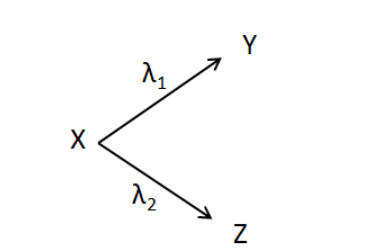
A radioactive nuclide X decays into nuclei Y and Z by simultaneous disintegration as shown. Effective decay constant for the disintegration is

(A) ${\lambda _1} + {\lambda _2}$
(B) $\dfrac{{{\lambda _1}{\lambda _2}}}{{{\lambda _1} + {\lambda _2}}}$
(C) $\dfrac{{{\lambda _1} + {\lambda _2}}}{2}$
(D) $\dfrac{{2{\lambda _1}{\lambda _2}}}{{{\lambda _1} + {\lambda _2}}}$
Answer
141.9k+ views
Hint: To solve this question, we need to use the general equation for the rate of nuclear disintegration. We have to apply the equation separately for the two decays of the given nucleus, and combine them to get the effective decay constant.
Complete step-by-step solution:
We know that the rate of the radioactive decay of a nucleus is proportional to the number of nuclei. And the constant of this proportionality is the decay constant. So the expression for the rate of the radioactive decay of a nucleus is written as
$ - \dfrac{{dN}}{{dt}} = \lambda N$
Now, according to the given nuclide X is being decayed into the two daughter nuclei Y and Z. And the decay constants for these two decays are given to be ${\lambda _1}$ and ${\lambda _2}$ respectively.
So we can separately write the equation for the rate of decay for these two decays. Writing the equation for the decay of X to Y, we get
$ - \dfrac{{d{N_X}}}{{dt}} = {\lambda _1}{N_X}$
Every decayed nucleus of X produces a nucleus Y. So we can write
$\dfrac{{d{N_Y}}}{{dt}} = {\lambda _1}{N_X}$...................(1)
Similarly for the decay of X to Z, we can write
$\dfrac{{d{N_Z}}}{{dt}} = {\lambda _2}{N_X}$.....................(2)
Adding (1) and (2) we have
$\dfrac{{d{N_Y}}}{{dt}} + \dfrac{{d{N_Z}}}{{dt}} = {\lambda _1}{N_X} + {\lambda _2}{N_X}$
$ \Rightarrow \dfrac{{d\left( {{N_Y} + {N_Z}} \right)}}{{dt}} = \left( {{\lambda _1} + {\lambda _2}} \right){N_X}$ (3)
Now, since Y and Z nuclei are produced from the nucleus X, so we can write
\[\dfrac{{d\left( {{N_Y} + {N_Z}} \right)}}{{dt}} = - \dfrac{{d{N_X}}}{{dt}}\]
Substituting this above, we get
$ - \dfrac{{d{N_X}}}{{dt}} = \left( {{\lambda _1} + {\lambda _2}} \right){N_X}$
Comparing with the general decay rate equation $ - \dfrac{{dN}}{{dt}} = \lambda N$, we get the effective decay constant for the given disintegration as
$\lambda = {\lambda _1} + {\lambda _2}$
Thus, the effective decay constant for the disintegration of the nucleus X into the nuclei Y and Z is equal to ${\lambda _1} + {\lambda _2}$.
Hence, the correct answer is option A.
Note: The phenomenon of radioactivity is used on a large scale to generate electric power. Also, it is used in the diagnosis and treatment of diseases in the field of nuclear medicine. The diseases which can be treated by radioactivity are thyroid, cancers etc.
Complete step-by-step solution:
We know that the rate of the radioactive decay of a nucleus is proportional to the number of nuclei. And the constant of this proportionality is the decay constant. So the expression for the rate of the radioactive decay of a nucleus is written as
$ - \dfrac{{dN}}{{dt}} = \lambda N$
Now, according to the given nuclide X is being decayed into the two daughter nuclei Y and Z. And the decay constants for these two decays are given to be ${\lambda _1}$ and ${\lambda _2}$ respectively.
So we can separately write the equation for the rate of decay for these two decays. Writing the equation for the decay of X to Y, we get
$ - \dfrac{{d{N_X}}}{{dt}} = {\lambda _1}{N_X}$
Every decayed nucleus of X produces a nucleus Y. So we can write
$\dfrac{{d{N_Y}}}{{dt}} = {\lambda _1}{N_X}$...................(1)
Similarly for the decay of X to Z, we can write
$\dfrac{{d{N_Z}}}{{dt}} = {\lambda _2}{N_X}$.....................(2)
Adding (1) and (2) we have
$\dfrac{{d{N_Y}}}{{dt}} + \dfrac{{d{N_Z}}}{{dt}} = {\lambda _1}{N_X} + {\lambda _2}{N_X}$
$ \Rightarrow \dfrac{{d\left( {{N_Y} + {N_Z}} \right)}}{{dt}} = \left( {{\lambda _1} + {\lambda _2}} \right){N_X}$ (3)
Now, since Y and Z nuclei are produced from the nucleus X, so we can write
\[\dfrac{{d\left( {{N_Y} + {N_Z}} \right)}}{{dt}} = - \dfrac{{d{N_X}}}{{dt}}\]
Substituting this above, we get
$ - \dfrac{{d{N_X}}}{{dt}} = \left( {{\lambda _1} + {\lambda _2}} \right){N_X}$
Comparing with the general decay rate equation $ - \dfrac{{dN}}{{dt}} = \lambda N$, we get the effective decay constant for the given disintegration as
$\lambda = {\lambda _1} + {\lambda _2}$
Thus, the effective decay constant for the disintegration of the nucleus X into the nuclei Y and Z is equal to ${\lambda _1} + {\lambda _2}$.
Hence, the correct answer is option A.
Note: The phenomenon of radioactivity is used on a large scale to generate electric power. Also, it is used in the diagnosis and treatment of diseases in the field of nuclear medicine. The diseases which can be treated by radioactivity are thyroid, cancers etc.
Recently Updated Pages
Young's Double Slit Experiment Step by Step Derivation

Difference Between Circuit Switching and Packet Switching

Difference Between Mass and Weight

JEE Main Participating Colleges 2024 - A Complete List of Top Colleges

JEE Main Maths Paper Pattern 2025 – Marking, Sections & Tips

Sign up for JEE Main 2025 Live Classes - Vedantu

Trending doubts
JEE Main 2025 Session 2: Application Form (Out), Exam Dates (Released), Eligibility, & More

JEE Main Exam Marking Scheme: Detailed Breakdown of Marks and Negative Marking

JEE Main 2025: Derivation of Equation of Trajectory in Physics

Electric Field Due to Uniformly Charged Ring for JEE Main 2025 - Formula and Derivation

Learn About Angle Of Deviation In Prism: JEE Main Physics 2025

Electric field due to uniformly charged sphere class 12 physics JEE_Main

Other Pages
JEE Advanced Marks vs Ranks 2025: Understanding Category-wise Qualifying Marks and Previous Year Cut-offs

JEE Advanced 2025: Dates, Registration, Syllabus, Eligibility Criteria and More

JEE Advanced Weightage 2025 Chapter-Wise for Physics, Maths and Chemistry

Degree of Dissociation and Its Formula With Solved Example for JEE

JEE Main 2025: Conversion of Galvanometer Into Ammeter And Voltmeter in Physics

Dual Nature of Radiation and Matter Class 12 Notes: CBSE Physics Chapter 11




